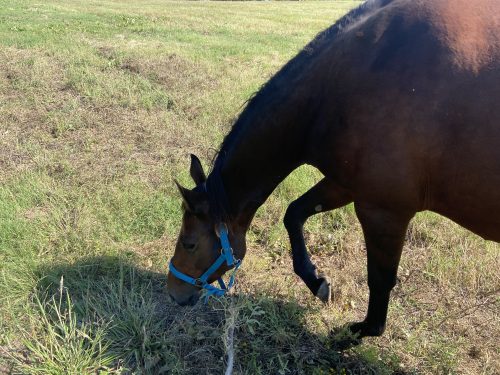As I wrote about in last week’s post, Chewie has moved to a new barn! In this post, I wanted to share a little more about how I introduced Chewie to her new home.

When a horse is introduced to a new pasture or a new group of horses, there is often a lot of running around. The running may be exuberant and exploratory. Or, it may be based out of fear or anxiety.
Running around in a new space can easily lead to an injury if the horse does not know the terrain or does not know where the fence lines are.
Introducing Chewie to her new pasture
I wanted Chewie to be happy, calm, and curious in her new home.
To introduce her to her new pasture, I used the constructional approach. That is, I thought in terms of “What behaviors do I want Chewie to perform as she gets to know this new environment?” I also asked myself the question, “How can I create a starting point so that these behaviors will be very likely?”
I knew that if I just turned Chewie loose in the new space, she was likely to start running around. I had seen her engage in this type of behavior several times when moving to a new pasture at the old barn.
Instead, I thought about what behaviors I wanted Chewie to do, including walking, stopping to look around, stopping to smell things, eating grass, and eating hay.
Then, I thought about some of the behaviors and activities that Chewie already knows that I could use to our advantage, such as wearing a halter, leading, targeting, and going for exploratory walks. I decided that a good starting point would be for Chewie and I to go for a long walk around her one-acre pasture.

Here are some of the things I did to help make our walk more successful:
- I let Chewie take me for a walk. That is, I let her set the pace and guide me. She got to explore the space and go wherever she wanted to go.
- At the same time, I kept Chewie on a halter and lead rope so that I could redirect her if she did get into any unsafe situations and so that I could limit her speed to walking only.
- If she started to trot (which happened twice), I used the lead rope and her existing cues to ask her to turn and to slow down to a walk. I think trotting happened rarely because of the starting point I picked. That is, she already associates our exploratory walks with walking and stopping.
- I let Chewie explore the pasture for around 30–40 minutes with me accompanying her, until she had covered the whole property at least once and I knew she had seen where all the fences were.
- As we walked, I also made sure she knew where her hay and water were located.
As we walked, Chewie stopped frequently to smell things, and she also would occasionally stop to graze. Then, she would start walking again. I let Chewie decide when she wanted to start and when she wanted to stop.

Throughout our walk, Chewie seemed curious, and she seemed fairly calm, especially given that she was in a new environment. Occasionally, she would stop and look around or would seem surprised by a new or interesting noise, such as the goats next door.
After around 30 minutes, Chewie was done exploring. She started eating from her hay net, then switched to grazing a bit, and then went back to the hay net.
At this point, I removed her halter and lead so that she was loose in the pasture.
All in all, I think she had a very successful introduction to her new pasture! She has continued to acclimate over the past week and now seems right at home in her new environment.
Our next step has been to slowly introduce her to her new donkey friend. I’ll write more about the steps I have been using to introduce them to each other in my next post!


No comments yet.